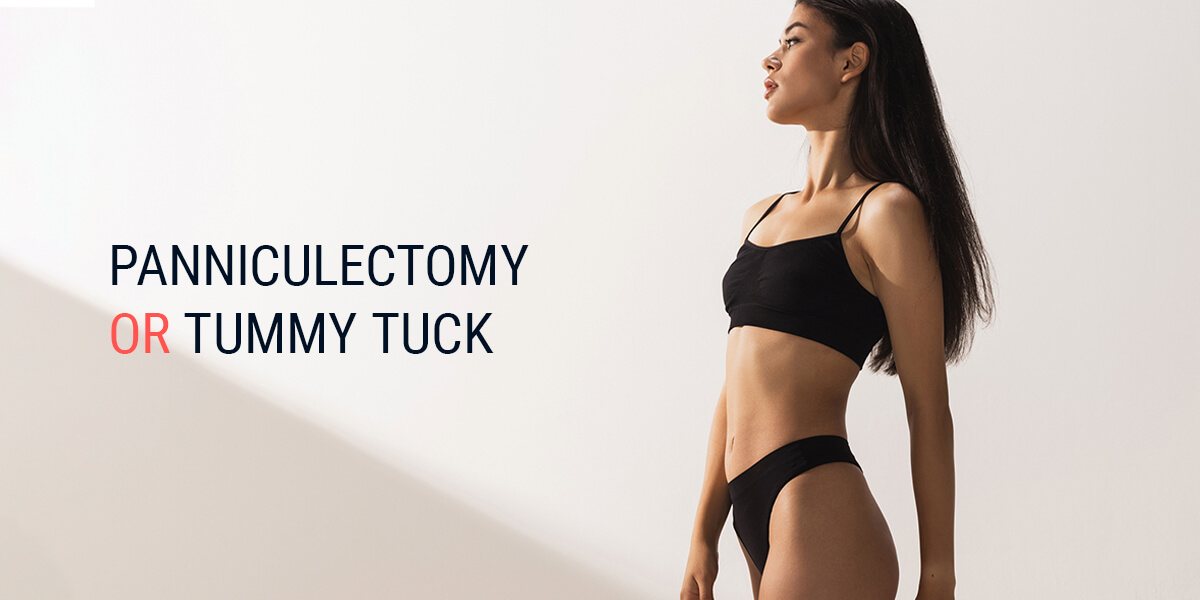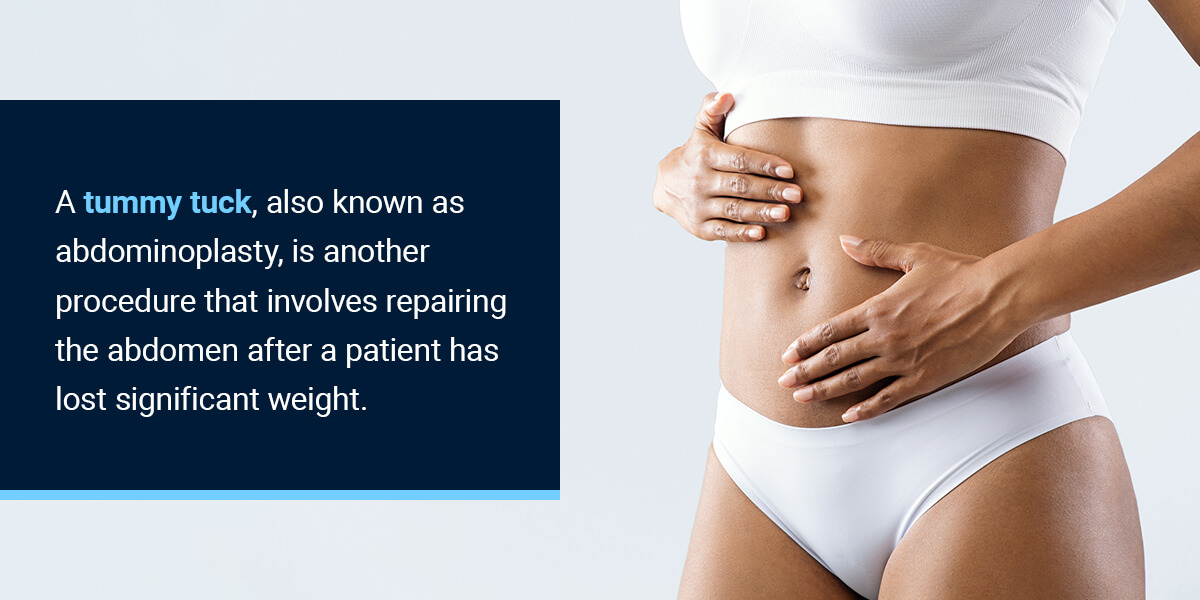Panniculectomy or Tummy Tuck

Significant weight loss can lead to excess skin around the stomach. For those who have lost a significant amount of weight, this can be a discouraging sight as it doesn’t show their progress and effort to reach their goal weights and bodies. Many people turn to surgical procedures to remove this loose skin and have a body that makes them feel comfortable and happy.
People often confuse tummy tuck and panniculectomy procedures because both involve removing loose skin near the abdomen. Both procedures provide a more slender and contoured appearance and can help patients better see their hard-earned progress. However, there are differences between a tummy tuck and a panniculectomy, and one may be significantly better suited for you.
Keep reading to discover the difference between these procedures and how to determine which one is right for you.
What Is a Panniculectomy?
A panniculectomy removes the excess skin around your abdomen after losing a large amount of weight. This skin that hangs in the lower abdomen, pubic area, and upper legs is known as the pannus, and this procedure can remove it to help you find the body you’ve worked so hard to achieve. You can get this contouring procedure by itself or pair it with a tummy tuck.
Many patients seek a panniculectomy procedure for various reasons, and it can benefit your body in multiple ways. People who have lost a significant amount of weight often find excess skin on their bodies that affects their appearance. Other people may have experienced pregnancy complications that result in the skin being unable to return to its previous elasticity and shape.
In some cases, this excess skin can hang as low as your knees, severely impacting your ability to perform daily functions, such as walking, running, standing, and sitting. Additionally, loose skin can cause skin disorders, ulcers, back problems, rashes, infection, and similar conditions.
During this procedure, the surgeon will make an incision on the lower part of the patient’s abdomen/pubic area. The result is removal of loose skin creating a more slender and contoured appearance.

What Is a Tummy Tuck?
A tummy tuck, also known as abdominoplasty, is another procedure that involves repairing the abdomen after a patient has lost significant weight. More muscles are involved in this process, making the procedure more extensive than a panniculectomy, though the outcome still presents a slender, more contoured appearance.
The plastic surgeon will create an incision in the pelvic area for this procedure to remove excess tissue. Another step in this procedure involves suturing the muscles to give them a more supported and tighter position.
Like panniculectomy, people seek tummy tuck procedures for various reasons. Significant weight changes, aging, pregnancy, and surgeries like a C-section can cause the skin to lose elasticity or weaken the abdomen’s connective tissues. This procedure can help eliminate stretch marks and pair well with other cosmetic surgeries, such as breast surgery.
There are multiple types of tummy tuck procedures you can get, which are:
- Complete: This procedure is best for patients needing extensive correction. The incision length will depend on the amount of excess skin a patient possesses, and there will typically be an additional incision around the belly button. The patient may require drainage tubes under the skin. If you need drainage tubes, you may keep them for a few weeks until the surgeon sees it fit to remove them.
- Partial: People with less loose skin can undergo a partial or mini-tummy tuck. This procedure may require a shorter incision, and the belly button typically stays in place without an incision around it. The surgeon will separate the skin between the incision line and the belly button, and the procedure may last up to a couple of hours.
- Fleur de Lis: Patients seeking this procedure will include areas of their back. Occasionally, large amounts of excess skin in the back can call for liposuction or circumferential procedures. During this treatment, the surgeon will remove fat and skin from the abdomen, hips, flanks, and back to improve body shape from all sides.
Which Treatment Is Right for You?
Although tummy tucks and panniculectomies seem similar, they have fundamental differences, and choosing the correct procedure can significantly benefit your mind and body. Keep in mind that it is possible to obtain both treatments simultaneously. Evaluate your body and weight goals to determine which treatment will offer your desired outcome.
Consider these factors when determining which treatment is best for you:
- Candidate type: The typical candidates seeking each treatment can let you know which procedure may be more beneficial. People seeking a panniculectomy often face loose skin of the lower abdomen and pubic areas that impedes their daily lives. They typically have large amounts of sagging skin, making it challenging to perform routine tasks. Tummy tuck procedure candidates may have less loose skin than panniculectomy patients but may have other concerns of the entire abdomen, such as diastasis of the rectus muscle which may require repair.
- Insurance: Due to the intrusive and harmful nature of the loose skin, a panniculectomy is often a medical necessity. Patients can experience severe health problems due to this condition, making it essential to remove the loose skin and fat. Although policies will vary by company, this procedure is more likely to have insurance coverage than a tummy tuck, which is almost always considered a cosmetic surgery.
- Cost: If your insurance does not cover either procedure, evaluating the price is essential. A tummy tuck averages more than $6,000 for patients, while panniculectomy treatments can cost over $10,000. Factors like anesthesia and other medical items can affect the overall price.
- Recovery time: Your age, post-surgery care, general health, and surgery type will affect your recovery time. Tummy tucks typically require around a month of recovery at home and away from work and activities. However, you should avoid drinking or smoking for at least three months after the surgery, and bruising and swelling may take as long to fade completely. It may take patients longer to recover from a panniculectomy, typically between four and six weeks, with the same parameters for drink and smoking.
Find the Procedure for You With Southern Plastic & Reconstructive Surgical Institute
You can find the supportive team you need at SPRSI. We pride ourselves on our outstanding patient care and holistic, comprehensive approach to each patient. Our team is highly specialized in a range of reconstructive and cosmetic procedures, empowering you to find the body you’ve always wanted.
At SPRSI, you can seek tummy tuck and panniculectomy treatments from Dr. Brought. Whether you’re looking for a tummy tuck procedure that will tighten your muscles to create a firmer abdominal wall and a smaller waistline or a panniculectomy procedure to remove debilitating excess skin and tissue, Dr. Brought is the surgeon you need.
Dr. Brought is prepared to change your life with the procedure you need the most. Contact us to learn more about these procedures or schedule a consultation.


